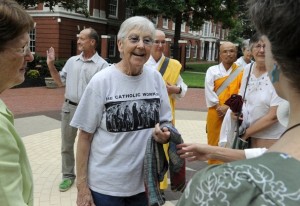
Sister Megan Rice, center, 82, and Michael Walli, back waving, 63, were greeted by supporters when they arrived at Federal Court Thursday, Aug. 9, 2012 in Knoxville. The third protester Greg Boertje-Obed, 57, is still in custody and was brought by authorities from the Blounty County jail. (MICHAEL PATRICK/NEWS SENTINEL)
The Y-12 Uranium bomb-making plant was closed for two weeks after anti-nuke peace activists breached security and redecorated the place a bit last month.
On August 9, a federal grand jury returned a three-count indictment against the Y-12 protesters, consolidating the previous charges lodged against them and adding another felony count of “depredation” of government property, involving cutting, painting and defacing that resulted in damages exceeding $1,000.
The new charge carries a maximum sentence of 10 years in prison and a fine of $250,000. All three have pleaded not guilty.
The indictment supersedes previous complaints filed against the three defendants — Sister Megan Rice, 83; Michael Walli, 63; and Greg Boertje-Obed — and a new trial date has set for Oct. 10 in front of U.S. District Judge Thomas W. Phillips.
The protesters, who labeled themselves the “Transform Now Plowshares,” infiltrated the Y-12 nuclear weapons plant in the predawn hours of July 28, finding their way to the plant’s highest-security area.
According to court documents, they used bolt cutters to get through three fences, tripping alarms in the process. They told acquaintances in the peace movement that they spent more than two hours inside the restricted area. The action culminated in the protesters spray-painting and throwing blood on the walls of the white fortress-like HEUMF structure.
The protest was in response to the preparations for building of a new multibillion-dollar uranium processing plant at Y-12.
Anti-war protesters have rallied at the gates of Y-12 for decades around the anniversary of the bombing of Hiroshima. Some deliberately trespass or block traffic to provoke arrest and call more attention to their cause. Some years, authorities have tried to deprive them of the notoriety by refusing to prosecute. Sometimes they go to federal court, but the stiffest sentence ever meted out was less than a year in prison.
This time, federal prosecutors have thrown the book at the three protesters.
“That’s the reaction to the embarrassment,” said Ralph Hutchison, of the loose-knit Oak Ridge Environmental Peace Alliance.
Previous protests around the plant — including one less than three months after 9/11 — have led to millions of dollars of security upgrades. But those haven’t prevented repeated lapses.
“We’re paying all that money for an illusion of security — and you really can’t secure the plant,” Hutchison said.
On New Year’s Day 2002, a dozen protesters marched onto the Y-12 facility carrying 14-foot flags and lighted candles. They stopped three times for prayer services, but were arrested only after being spotted by a passing motorist who reported them to guards.
Since then, more guards have been added, concrete barriers have been built and other security measures taken to meet protective standards described as three times tougher than before 9/11.
But security miscues have persisted. For example, Seven guards were caught napping at Y-12 between 2000 and 2008.

no nukes !!!!
thanks